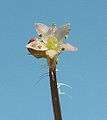Hydrocotyle vulgaris
Hydrocotyle vulgaris, also known as marsh pennywort, common pennywort, water naval, money plant, lucky plant or copper coin,[2] is a small creeping perennial aquatic herb native to N. Africa, Europe, the Caucasus and parts of the Levant.
| Hydrocotyle vulgaris | |
|---|---|
 | |
| Scientific classification | |
| Kingdom: | Plantae |
| Clade: | Tracheophytes |
| Clade: | Angiosperms |
| Clade: | Eudicots |
| Clade: | Asterids |
| Order: | Apiales |
| Family: | Araliaceae |
| Genus: | Hydrocotyle |
| Species: | H. vulgaris |
| Binomial name | |
| Hydrocotyle vulgaris | |
Description
The plant has an umbrella-like leaf and lives commonly in wet places such as wetlands, marshes, and swamps sometimes even in deeper water. It grows as a perennial herbaceous plant and only reaches stature heights of 5 to 20 centimeters. With a slight smell of carrot, they are edible.
This marsh plant forms numerous, up to 1 meter long, creeping offshoots. The serrated, rounded, shield-shaped leaves can have a diameter of up to 4 centimeters, but are often smaller. The approach of the long, hairy petioles is located in the middle of the leaf underside. The leaves are fresh green, shiny waxy and shows a clear, radially extending vein.
The tiny, inconspicuous, hermaphrodite flowers are in low-flowered doldigen inflorescences or whorls, with the stems of the inflorescence are about half as long as those of the leaves. The petals are greenish, white or reddish. The flowering period is from July to August. The nut fruits are flat, warty and winged.[3]
Cultivation
A low maintenance plant, it prefers to grow in humus, reliably moist soils under a full sun or part shade, indoors or outdoors, though it can tolerate full shade as well. It may also be grown as an aquatic plant in mud at the side of a pond or water garden in up to 2 inches of stagnant water. Despite its habitat in water, over watering may still cause root rot.[4]
Population
The plant is distributed and plentiful throughout much of its range in Europe, North Africa and Western Asia. Nonetheless, it is classed as Critically Endangered in Croatia, Vulnerable in Switzerland and Near Threatened in Norway. Furthermore, the plant is protected under regional legislation in France.[5]
Ecology
In Britain it is the only native Hydrocotyle, growing in wet places such as fens, swamps, bogs and marshes. For example, it is a component of purple moor grass and rush pastures – a type of Biodiversity Action Plan habitat. The flowers rarely bloom; mostly self-pollination takes place. Vegetative propagation occurs through foothills. In wild plant gardens, the marsh pennywort is used for the planting of garden ponds, and also as aquarium plant.[6]
Gallery
- UFO-shaped leaf
 Flower
Flower Inflorescence
Inflorescence Botanical illustration by German botanist Otto Wilhelm Thomé
Botanical illustration by German botanist Otto Wilhelm Thomé
See also
- Umbilicus rupestris, a similar looking succulent
- Pilea peperomioides, a similar looking rosales
References
- Lansdown, R.V. (2014). "Hydrocotyle vulgaris". IUCN Red List of Threatened Species. 2017: e.T164201A42415437.
- "BSBI List 2007". Botanical Society of Britain and Ireland. Archived from the original (xls) on 2015-01-25. Retrieved 2014-10-17.
- Siegmund Seybold (ed.): Schmeil-Fitschen interactive . CD-ROM version 1.1. Quelle & Meyer, Wiebelsheim 2002, ISBN 3-494-01327-6 .
- Christel Kasselmann: Aquarienpflanzen. Ulmer Verlag, Stuttgart 1995; 2., überarbeitete und erweiterte Auflage 1999, ISBN 3-8001-7454-5, S. 306.
- Lansdown, R.V. 2014. Hydrocotyle vulgaris. The IUCN Red List of Threatened Species 2014: e.T164201A42415437.
- Manfred A. Fischer, Wolfgang Adler, Karl Oswald: Excursion flora for Austria, Liechtenstein and South Tyrol . 2nd, improved and extended edition. Upper Austria, Biology Center of the Upper Austrian Provincial Museums, Linz 2005, ISBN 3-85474-140-5 .
External links
| Wikimedia Commons has media related to Hydrocotyle vulgaris. |
- Wildflower.org.uk website giving photographic description of the plant
